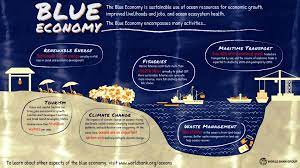
Global Maritime India Summit (GMIS) 2023 Blue Economy
Global Maritime India Summit (GMIS) 2023 Blue Economy
Important for Prelims:
Global Maritime India Summit (GMIS) 2023, 'Amrit Kal Vision 2047', 'Blue Economy', Tuna Tekra Deep Draft Terminal
Important for Mains:
GS-3: Highlights of Global Maritime India Summit (GMIS) 2023, India's position in 'Blue Economy', prospects, challenges
October 21,2023
Context:
- Prime Minister Shri Narendra Modi inaugurated the third edition of the Global Maritime India Summit (GMIS) 2023 on October 17, 2023.
Global Maritime India Summit (GMIS) 2023
- This summit took place from 17 to 19 October at MMRDA Grounds in Mumbai.
- The summit discussed key maritime sector issues including future ports, decarbonization, coastal shipping, inland water transport, shipbuilding, finance, insurance, maritime clusters, innovation, safety, security and tourism.
- The objective of the summit is to attract investment in India's maritime sector.
- The long-term blueprint for the Indian Ocean Blue Economy 'Amrit Kaal Vision 2047' was unveiled at the event.
- 'Amrit Kaal Vision 2047' is a strategic plan that focuses on enhancing port facilities, sustainable practices and international cooperation in the Indian maritime sector.
- The summit laid the foundation stone for important projects including the Tuna Tekra Deep Draft Terminal and presented over 300 MoUs worth over Rs 7 lakh crore for global and national partnership in the maritime sector.
Tuna Tekra All-Weather Deep Draft Terminal:
- This greenfield terminal will handle next generation vessels and facilitate Indian trade through the India-Middle East-Europe Economic Corridor (IMEC).
- The cost of this terminal, established at Deendayal Port Authority in Gujarat, is Rs 4,500 crore.
|
About Maritime India Summit (GMIS): The first Maritime India Summit was held in Mumbai in 2016, while the second edition was held virtually in 2021. |
About 'Blue Economy':
- 'Blue economy' is an emerging concept that encourages better management of ocean or aquatic resources.
- Under this, the aim is to make better use of marine resources for economic development as well as better livelihood and employment while preserving the health of the marine ecosystem.
Features:
- Uses smart shipping to reduce impact on the environment.
- Inclusive and improves life for all.
- Immense potential of renewable energy.
- Creates jobs, reduces poverty and eliminates hunger.
- Takes action against illegal fishing.
- Protects marine life and oceans.
- Protects coastal communities from the effects of climate change.
- Tackles marine litter and pollution of the oceans.
Significance:
According to the Indian Ocean Rim Association (IORA):
- Blue Economy will contribute to food security, poverty alleviation, climate change mitigation and resilience, socio-economic development, increased trade and investment, enhanced maritime connectivity, enhanced diversification and employment generation.
- Blue Economy is an innovative and dynamic business model, which will strengthen the business relationship between India and other related countries, especially the countries located in the Indian Ocean region.
- Blue Economy will increase economic cooperation with coastal states in India's neighbourhood.
India's position in Blue Economy
- Blue economy contributes about 4% to India's GDP.
- Fisheries and minerals are the two most viable components of the blue economy in India.
- India is the world's second largest fish producer and has a fleet of 250,000 fishing boats.
- The coastal economy supports more than 4 million fishermen.
- Two mineral deposits of commercial importance to developers in the Indian Ocean are polymetallic nodules and polymetallic massive sulphides.
- Polymetallic nodules contain nickel, cobalt, iron and manganese and grow over millions of years on the sea floor. These are often discovered at a depth of 4-5 kilometers. In 1987, India was given the exclusive right to explore polymetallic nodules in the Central Indian Ocean Basin.
- The Blue Economy of the Indian Ocean has become a global economic corridor with India's international commitments in the region under UNCLOS to combat search and rescue, maritime mining and piracy.
- Emerging sectors in India are renewable ocean energy including offshore wind, tidal and wave energy, offshore extraction of oil and gas, marine aquaculture, etc.
Conclusion:
- 90 percent of India's total business happens through sea route. At the same time, 80 percent of global trade happens through sea. 40 percent of the world's population lives near the sea. More than 3 billion people in the world depend on the oceans for their livelihood. Given the important role of oceans in the Sustainable Development Goals, it is very important to harness the power of the blue economy. Focusing on Blue Economy in India can prove to be very beneficial for the economy. For this, India needs to overcome the challenges related to it.
Source: PIB
---------------------------------
Mains Exam Question
India is on its way to strengthen its Blue Economy through the Global Maritime India Summit (GMIS) 2023. Discuss.